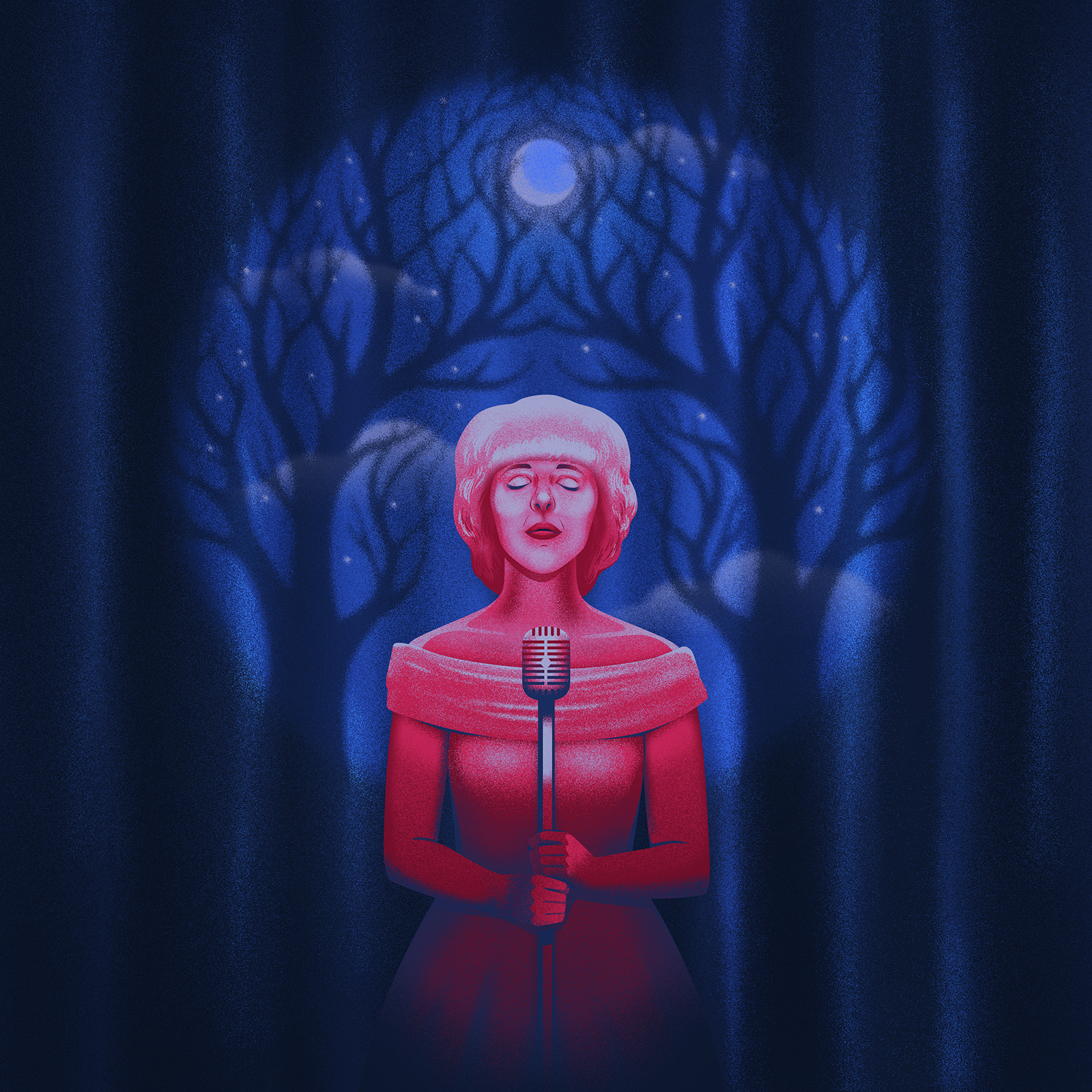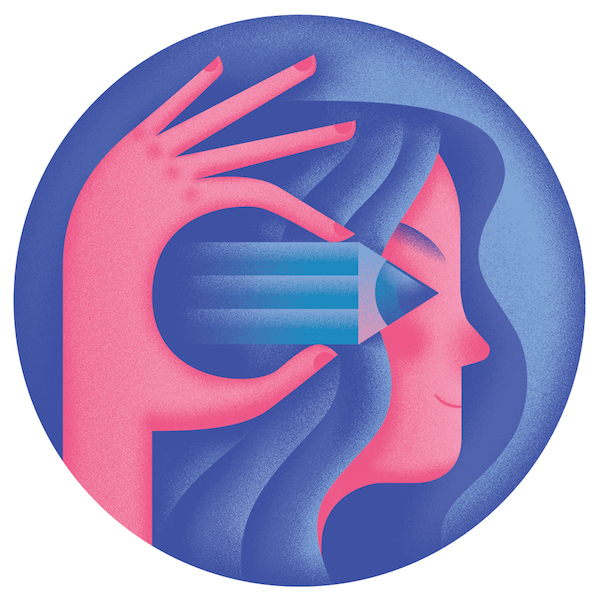Guest Album Review – “Floating Into The Night” by Julee Cruise
This guest review was originally part of a music blog project I created called Under The Deer. Since that site won’t be around forever, I’m archiving these wonderful reviews and their accompanying illustrations here. Writer and illustrator listed at end of the review.
“What do you see David? Just talk to me.”
“OK, Angelo. We’re in the dark woods now, there’s a soft wind blowing through some sycamore trees, the moon’s out, you can hear the hoot of an owl. Get me into that beautiful darkness with the soft wind. From behind the trees, in the back of the woods, there’s this lonely girl. Her name is Laura Palmer.
She’s very sad… That’s it! I can see her! She’s walking towards the camera!
She’s getting closer… Now she’s starting to leave… Fall back. Keep falling. Keep falling. Keep falling. Just go back into the woods…”
It’s a short video. We see Angelo Badalamenti behind his keyboard. He’s setting the scene. He plays an embryonic chord progression, narrating the events of an evening he spent with David Lynch. It’s a simple dialogue: Lynch describes the Twin Peaks of his mind as Badalamenti responds with melody. Lynch has a vision: a collage of imagery will slowly begin to converge into a coherent form, first as spoken word, and then, ever so subtly, under Badalamenti’s fingers. The result is frankly faint-making. The heart-wrenching song we heard was soon to become Laura Palmer’s theme in the now-legendary TV show Twin Peaks, with Julee Cruise lending her velvety vocals to its studio version, aptly titled “Falling”.
David Lynch imagined a dark forest, Angelo Badalamenti made a lonely girl manifest in its darkness, and Julee Cruise came to be the soft wind, rustling the Sycamore leaves into a reverberant nocturnal hush. With lyrics by Lynch, music by Badalamenti, and vocals by Cruise, the trio wrote an alleged 40 songs, only ten of which appeared in the final track listing of Floating Into the Night.

Julee Cruise’s Floating Into the Night has haunted me for years. It’s an incredibly misleading album. At first, its warm tones, intermittent mellifluous brass and omnipresent wall of synthesizers might sound comforting; But it doesn’t take long to find deeply unsettling truths at its core, an uncanny sense of discomfort that can’t be shaken easily.
But First, let’s take a few steps back to look at the bigger picture. During the production of David Lynch’s Blue Velvet (1986), when the rights to This Mortal Coil’s rendition of “Song to the Siren” proved too expensive, Angelo Badalamenti was tasked with recreating the same dreamy quality in an original composition of his own. Having previously worked with Julee Cruise, she was to become the vocalist for “Mysteries of Love”, a song that appears in Floating Into the Night a few years later.
Though Lynch had received critical acclaim previously, it was Blue Velvet that truly brought his obsession with small-town America to a wider audience. Lynch was to become a household name in American arthouse cinema; injecting new vigor into the independent film scene. David Lynch has been discussed ad nauseam, but to further understand the underlying structure of Floating Into the Night, certain aspects of his work need to be discussed.
Born in 1946, the post-war economic growth was to be the eerily optimistic era in which Lynch spent his childhood. We’ve all seen the posters, we’re familiar with that smile: the docile smile of a white middle-class housewife, selling a wide array of products. Most of us have heard the pop songs as well; men with sonorous voices singing songs of sophomoric love, or women with schoolgirl voices singing of “being a fool”. The fetishization of the docile All-American, smiley housewife was at its pinnacle, and the Second World War provided the perfect excuse for capitalism. Capitalism was to become the American way, and consumers were patriots who actively fought the looming threat of communism.
Lynch was born in a small town in Montana, but his father’s job required him to move around the country, often settling in small towns. American suburbia was the poster boy for the American dream; safe streets, white picket fences, disposable income, impeccable gardens and beautiful rosy-cheeked families who spent their free time being consumers.
Now let’s fast forward a few decades. It’s 1986 and we’ve just bought tickets for Blue Velvet. Bobby Vinton’s “Blue Velvet” plays as we watch a seemingly disconnected collage of imagery: We see a clear blue sky. We see a white picket fence ornate with red roses. We see the local firefighter and his dalmatian ride through the lane, waving to the camera with a Cheshire Cat grin. A housewife watches a murder mystery on the television as her husband mysteriously falls to his death while watering his plants in the garden. Bobby Vinton’s voice fades out so we can hear the sound of insects swarming in the soil. Later, a man walking through the grass finds a dismembered ear being devoured by ants. Lynch gives new meaning to the word “eerie” (pun intended!) and brings the unsettling truth of American suburbia to the fore. The discomfort of the pain and suffering underneath that omnipresent smile that has erased the working class from pop ephemera.
Now let’s fast forward to 1989 and start listening to Floating Into the Night. The words are rather simple: trials and tribulations of young love in the style of fifties lounge singers. However, there’s one minor tweak that makes a world of difference: the recurrent mention of “night” and “darkness”, words eerily absent from songs of this ilk. It would be a stretch to pseudo-philosophize and immediately make connections that may or may not have been intended, but for me, this is where the album begins to make a statement.
It’s the Eighties. Our post-war kids have grown up. They have children of their own. It’s their prom night. They dance in circles under the disco ball as Julee Cruise sings “floating into the night” from start to finish. They float in the “night” ironically absent in the tapestry of the American “Dream”. They now dance in the viscosity of the night, the advent of their “Dream” to come.
It’s no coincidence that this album was deemed one of the pioneers of “dreampop”. The soothing wall of sound, with its synthetic, oohs and aahs, helps set a romantic tone for a slow dance, a looming kiss, intermittently interrupted by subtle hints that this is not the All-American prom night they’ve been promised throughout childhood.
The third Track “I Remember” starts slow and soothing, with a soft saxophone solo in the middle.
I remember your smile
And the way you sent it to me
So many times through different air
It lives inside my heart
And suddenly, discordant bells chime, taking us out of that comfort with unexpected words and disharmonious melody
Is it a dream?
You and me
It can’t be real
“Rocking Back Into My Heart” has a strange few lines that can be easily missed. The chorus repeats a few times:
I want you
Rockin’ back inside my heart
But before the second verse we hear:
Shadow in my house
The man, he has brown eyes
She’ll never go to Hollywood
Love moves me
I’ve ruminated upon the implications of this album for years; perhaps overthinking, overanalyzing. As a millennial, my second-hand nostalgia for the Eighties drew me towards Julee Cruise. I often listen to this album while walking through dark winter-stricken trails thinking of a passage from Emmanuel Levinas’ “Existence And Existents”:
“When the forms of things are dissolved in the night, darkness of the night, which is neither an object nor the quality of an object, invades like a presence. In the night, where we are riven to it, we are not dealing with anything. But this nothing is not that of pure nothingness. There is no longer this or that; there is not “something.” But this universal absence is in its turn presence, an absolutely unavoidable presence.”
“Night” is the ultimate unavoidable presence, of fears, of the omitted truths, of the forgotten, of the eluded fundaments of the human condition. And here, in this album, with a few soft chords, we slowly float away into its viscous night…
“That’s it! I can see her! She’s walking towards the camera!
She’s getting closer…
Now she’s starting to leave…
Fall back.
Keep falling.
Keep falling.
Keep falling.
Just go back into the woods…”
Contributors

Khashayar Mohammadi is an Iranian-born writer/toque-enthusiast based in Toronto. He is currently working as an editor for the independent publishing company Inspiritus press.

Cat Finnie is a freelance illustrator based in London, UK. She likes to create digital illustrations that have a surreal edge.